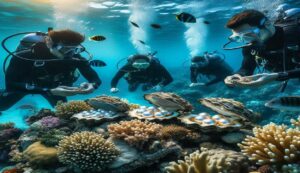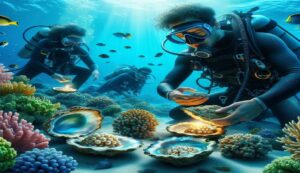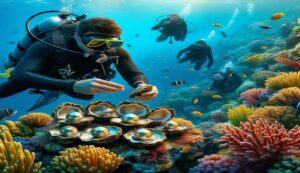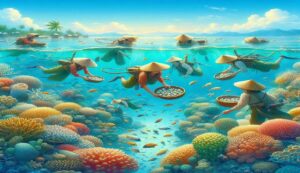Pearl Farming: Beginners should follow this guide for pearl farming
Pearl Farming: For those who are interested in beginning pearl farming, the following page offers some basic information regarding freshwater pearl culture. Pearl farming is perhaps one of the most difficult aquaculture ventures, particularly if you want to start from zero. The high market value of pearls is the primary benefit of pearl farming or pearl production. The finished product is non-perishable and lightweight apart from this. The nicest thing about pearl farming is that, apart from the grafting process, it’s a rather straightforward aquaculture enterprise since pearls don’t need artificial feeds, particularly marine ones.

A mollusk produces pearl, which is regarded as a natural jewel. The most exquisite stones that we have access to are pearls, which are also among the most sought-after in the world due to their very wonderful aesthetic appeal and competitive pricing. From whence do these pearls originate? Naturally occurring pearls may be found in seashells, but cultivated pearls are created when mussels are surgically nucleated, starting the pearl-forming process.
In principle, every mollusk with a shell may generate a pearl of some kind, but those with nacre or pearl lining on the inside of the shell surface can produce pearls that are glossy and shine. How are these pearls made? The basis for pearl cultivation operations was, in fact, an aberrant reaction to a foreign material in the regular biological processes that give certain mollusks their shells. The tissue that really produces pearl nacre is the mantle, with its outer epithelial cells. A pearl is produced when an external stimulation, such as the unintentional entrapment of a hard foreign substance in the outer epithelium of the mantle tissue, results in the foreign body. We can declare with certainty that the pearl is nothing more than a calcium carbonate deposit found in the soft tissue of oysters with shells. On the other hand, freshwater pearl cultivation (cultured pearls) uses a different procedure for pearl production. In freshwater pearl farming, the pearl-forming process is often started by surgically nucleating mussels.

How much time does pearl formation take? The time it takes for a pearl to develop might range from a few months to many years, depending on the species of mussel.
Seawater/saltwater cultivated pearls, freshwater cultured pearls, Japanese cultured pearls, Keshi pearls, and mabe pearls are among the varieties of pearls. There are eight primary forms of pearls: button, oval, baroque, pear, round, semi-round, button, drop, and double bouldered. Perfect round pearls, on the other hand, are more expensive. In terms of global pearl production, China is the leader.
Three types of pearls are produced by pearl cultivation: freshwater, seawater, and natural pearls. “Freshwater Pearl Culture” is the topic of discussion in the text that follows.
Countries that produce pearls
Among the top producers of pearls are China, Japan, Australia, the South Seas, Vietnam, India, United Arab Emirates, the United States, Mexico, Fiji, the Philippines, France, Myanmar, and Indonesia.
Pearls in Indian Languages
मोती/Motee/Moti (Hindi), Muthyalu (Telugu), മു്തുക്/Muttukaḷ (Malayalam), ಮುತ್ತುಗಳು / Muttugaḷu (Kannada), முத்துக்க௳்/ Muttukkaḷ (Tamil), મોતી/Mōtī (Gujarati), মুক্তো/Muktō (Bengali), and मोती/Mōtī (Marathi).

Techniques for Implantation
The techniques used to operate on freshwater pearls often rely on the kind of pearl that is wanted as well as the internal surgery performed on the mussel. A shell bead may be a crucial component of pearl culture operations, and cheap, readily accessible biocompatible acrylic material can be used as the building blocks for freshwater pearl synthesis. The optimal pearl mussels for pearl farming are those with a shell length of 8 to 10 cm and a weight of 50 grams or more.
Important things to consider
Before beginning a pearl farming or culture, take into account the following information and essential aspects.
Success in pearl farming demands a sustained commitment of resources, including time, money, and labor.
The secret to increased revenues is producing pearls of superior grade.
Production of pearls of superior grade may only occur under certain, optimal circumstances.
A trustworthy supplier of pearl oysters
An appropriate place or places
Enough money or investment to start and run the pearl farm
Availability of grafting technicians
Capacity to properly market pearls
It is advisable to seek out other agricultural opportunities if any of the aforementioned requirements cannot be met, rather than taking a chance.
Processes Associated with Freshwater Pearl Farming (Culture Practices): The freshwater pearl culture operations consist of six key processes, which are covered here:
In pearl farming, a duty that involves gathering oysters or mussels is gathering healthy mussels from freshwater sources like rivers and ponds. It is recommended to hand gather these mussels and store them in buckets, pots, or other containers with water. For freshwater pearl cultivation, it is advised to utilize a length of anterior-posterior more than 8 cm.
Pre-culture (operational) Conditioning: Following their collection, mussels and oysters should be ready for two to three days of pre-culture conditioning. This involves maintaining the mussels in captivity in a crowded state with old tap water at a stocking density of one mussel per liter of water. Pre-culture conditioning facilitates the simple handling of mussels during surgical procedures.
Grafit and Nuclei Implantation/Mussel Surgery in Pearl Farming: Depending on the location, there are three possible approaches to do this.
Mantle Cavity Implantation in Pearl Farming: In this procedure, the two valves of the species should be opened, carefully separating the mantles of the anterior sides from the shell with a surgical set, and then beads with a diameter of approximately 4 to 6 mm should be inserted into the mantle cavity region of the mussel. Be sure the mussels are not injured at either end during this stage. Both valves’ mantle chambers are suitable for mantle cavity implantation.
Mantle Tissue Implantation in Pearl Farming: The mussels used in this procedure should be split into two groups: the recipient group and the donor group. Preparing the graft—a little piece of mantle tissue—is an essential step in the process. To do this, prepare a mantle ribbon from a donor mussel group and cut it into tiny, two-millimeter-by-two-millimeter pieces. The recipient mussels—which come in two varieties—should undergo the implantation: “non-nucleated” and “nucleated.” In the nucleated procedure, a tiny 2 mm diameter nucleus is put in the pockets after a grafted piece, while in the former method, only the graft pieces are introduced into the pockets generated at the inner side of the posterior pallial mantle. Ensure that neither the graft nor the nucleus emerges from the pocket in any scenario. Both valves’ mantle ribbons are suitable sites for implantation.

In pearl farming, gonadal implantation involves preparing grafts according to the mantle tissue method’s instructions. Priority one should be given to cutting the mussel at the edge of its gonad. To maintain intimate contact between the nucleus and graft, a graft should be placed into the gonad after a nucleus with a diameter of two to four millimeters. Ensure that the intestine is not cut during the surgical operation and that the nucleus of the transplant contacts the outer epithelial layer.
Mussels implanted in pearl farms should be maintained in post-operative care units, such as nylon bags, for ten to eleven days after surgery. During this time, they should get antibiotic treatment and be given access to natural food sources. Every day, these units should be inspected to make sure that no dead mussels or ones that reject the nucleus remain.
Pond Culture in Freshwater Pearl Farming: The implanted mussels should be put back into the ponds after their surgical treatment. The mussels should be stored in nylon bags, normally with two mussels per bag, and hung from PVC pipes or bamboo sticks in ponds that are one meter deep. The ideal stocking density for the mussels is between 25,000 and 30,000/ha. To maintain the productivity of the plankton, the ponds need be frequently treated with both organic and inorganic fertilizer. During the 12- to 20-month cultivation period, mussels should be periodically examined to eliminate any dead ones, and bags should be cleaned. When it comes to feeding, groundnuts, algae, and cow manure are often used.
Pearl and mussel harvesting: The mussels should be collected at the conclusion of the culture phase. Remove each pearl individually from the living mussels’ gonads or mantle tissue. But in the case of the mantle cavity approach, the mussels are sacrificed.
Pearls’ finished product
The following are the goods acquired via various surgical implantation techniques:
1. Using the mantle cavity approach, shell connected half-round and shell attached picture pearls
2 . Create tiny round or irregular pearls using the mantle tissue technique
3. And detached large round or irregular pearls using a gonadal technique.

